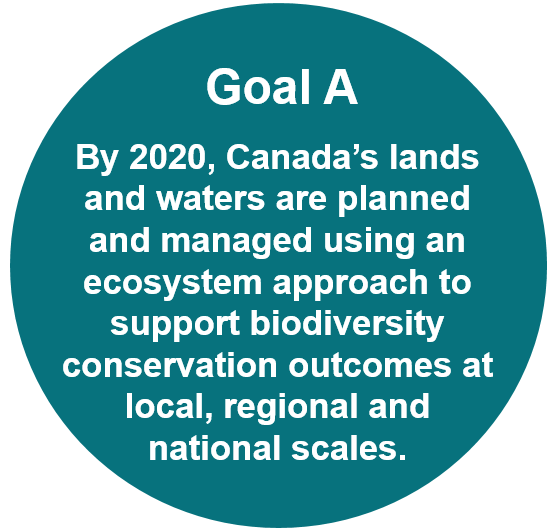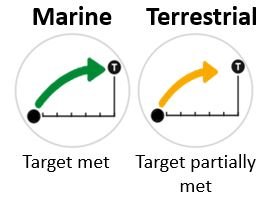Canada Target 1. By 2020, at least 17 percent of terrestrial areas and inland water, and 10 percent of coastal and marine areas, are conserved through networks of protected areas and other effective area-based conservation measures.
About the Target
Canada’s natural spaces are vital to our culture, heritage, well-being, and economy. Conserving Canada’s forests, wetlands, prairies, tundra, oceans, freshwater, and coastal areas contributes to biodiversity conservation, while improving the health of ecosystems. In turn, healthy ecosystems provide benefits such as clean air and water, pollination, mitigation of climate change, buffering from extreme weather events, and opportunities for people to connect with nature.
Protected and conserved areas include protected areas and other effective area-based conservation measures (OECMs). Examples of protected areas include national/provincial/territorial parks, national wildlife areas, migratory bird sanctuaries, marine protected areas, and some privately-owned protected areas. OECMs are areas that may not have biodiversity conservation as their primary objective but are managed in a way that conserves biodiversity over the long term. Pathway to Canada Target 1’s, One with Nature[i] report was released in 2019 and provides guidance to meet the terrestrial and inland water components of this target. Indigenous Protected or Conserved Areas (IPCAs) may be, or include, either protected areas or OECMs, depending on the circumstances. Creating protected and conserved areas is key to providing a living, diverse legacy for future generations of Canadians.
Canada Target 1 is linked with the following global Aichi target under the United Nations Convention on Biological Diversity Strategic Plan for Biodiversity 2011-2020:
Aichi Target 11 - By 2020, at least 17 per cent of terrestrial and inland water, and 10 per cent of coastal and marine areas, especially areas of particular importance for biodiversity and ecosystem services, are conserved through effectively and equitably managed, ecologically representative and well connected systems of protected areas and other effective area-based conservation measures, and integrated into the wider landscapes and seascapes.
[i] Pathway to Target 1: One with Nature (2019): The Pathway — Conservation 2020.
2020 Final Assessment
As of the end of 2020, 13.9% of Canada's coastal and marine areas were recognized as conserved through a network of marine protected areas and OECMs, and 13.0% of terrestrial areas and inland water were recognized as conserved through protected areas and OECMs, including 12.2% in protected areas.
Canada has achieved and surpassed its target to conserve 10% of coastal and marine areas by 2020. Building on this success, Canada must now turn towards a new target of conserving 25% by 2025 and 30% by 2030, and continue to take action to ensure that Canadians benefit from healthy coastal and marine ecosystems over the long term.
Canada partially met its target of conserving at least 17% of terrestrial areas and inland water by 2020, making significant progress towards the foundations needed for future protection with 12.2% of areas protected. Pan-Canadian definitions for recognizing and reporting on protected areas and OECMs and guidance related to IPCAs were established as part of One with Nature: A renewed approach to land and freshwater conservation in Canada. Collective accomplishments, lessons learned and a new suite of proposed actions for area-based conservation are highlighted in The Pathway Journey: A look back at a renewed approach to land and freshwater conservation in Canada. More collective priority, effort and tools to assist with the conservation of terrestrial areas and inland water are required to ensure that Canada is on track to reach its newer target to conserve 25% of terrestrial areas and inland water by 2025 and 30% by 2030. This work will need to involve all levels of government, Indigenous communities and organizations, conservation partners such as land trusts, and the broader public.
Contributing Actions
Recent significant work to establish terrestrial protected and conserved areas include:
In 2019, the Thaidene Nene National Park Reserve, co-managed between Parks Canada and Indigenous Governments: Łutsël K’é Dene First Nation, Northwest Territory Métis Nation, Deninu Kųę First Nation, and Yellowknive’s Dene First Nation, along with Thaidene Nëné Wildlife Conservation Area, and the Thaidene Nëné Territorial Protected Area, were designated as an Indigenous Protected and Conserved Area by the Łutsël K'é Dene First Nation, adding 26,000 km2 of protected area in the Northwest Territories;
In 2019, Kitaskino Nuwenene Wildland Provincial Park added 1,600 km2 of protected area in Alberta and further expanded to over 3,000 km2;
In 2020, St. Marys River Provincial Park added parcels totaling 32 km2 in Nova Scotia.
Additional effort is focused on the conservation of coastal and marine areas. Some recent initiatives include:
In 2019, amendments were made to the Oceans Act enabling the Minister of Fisheries, Oceans and the Canadian Coast Guard to designate Marine Protected Areas (MPAs) through the use of a Ministerial order, providing protection to vulnerable areas while further scientific research and consultation take place. The Act was also modernized to align with other environmental legislation in terms of fines, punishments, and enforcement provisions;
In 2019, Fisheries and Oceans Canada established the Tuvaijuittuq Marine Protected Area. Fisheries and Oceans Canada and Parks Canada had identified the area as a critically important habitat for Arctic under-ice and ice-associated communities. The Ministerial order provides protection for up to 5 years while the Qikiqtani Inuit Association, the Government of Nunavut and the Government of Canada work with Inuit and northern partners to explore the feasibility of longer-term protection for this area. This MPA contributes 5.55% towards Canada’s marine conservation targets and encompasses an area of 319,411 km2;
In 2019, Canada adopted new protection standards for federal MPAs and OECMs to better conserve sensitive and important parts of our oceans. That same year, the Laurentian Channel MPA was the first MPA to be established that applied Canada’s new protection standards;
In July 2020, Canada joined the Global Ocean Alliance, which is advocating to protect at least 30% of the world’s oceans through the establishment of MPAs and OECMs by 2030.
Pathway to Canada Target 1 is a collaboration between federal, provincial, territorial, Indigenous, local government and ENGO partners. Its four collective priorities are to:
Expand the systems of federal, provincial and territorial protected and conserved area;
Promote greater recognition and support for existing Indigenous rights, responsibilities and priorities in conservation;
Maximize conservation outcomes; and,
Build support and participation for conservation with a broader community.
Ecological integrity of national parks Park ecosystems have integrity when their native components such as native species and biological communities, natural landscapes, and functions, are intact and likely to persist. Representative components of major park ecosystems such as forests, freshwater, and wetlands, are monitored to determine their condition and trend. As of 2020, the ecological integrity of 82% of national park ecosystems was maintained or improved.
National parks are interlinked with their surrounding ecosystems and are affected by many of the same pressures on the environment. Some of the stressors affecting ecosystems in Canada’s national parks include:
habitat loss and degradation;
reduction of landscape connectivity (e.g., building of roads and trails);
climate change impacts (e.g., increasing temperatures) and climate-mediated ecological changes and cumulative effects (e.g., diseases and natural disturbances);
loss of keystone species (e.g., wolves or bison);
pollution and contaminants; and,
invasive species.

